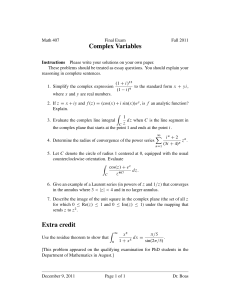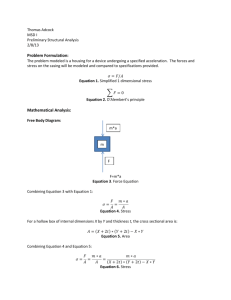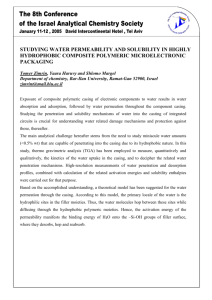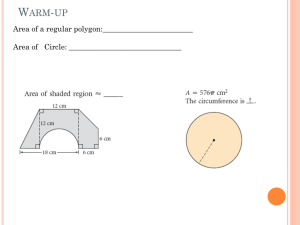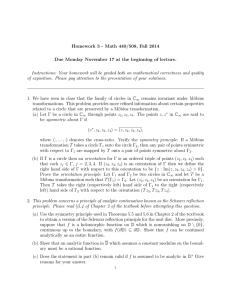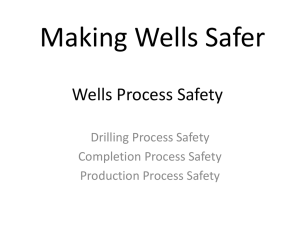Research Journal of Applied Sciences, Engineering and Technology 5(17): 4246-4256,... ISSN: 2040-7459; e-ISSN: 2040-7467
advertisement
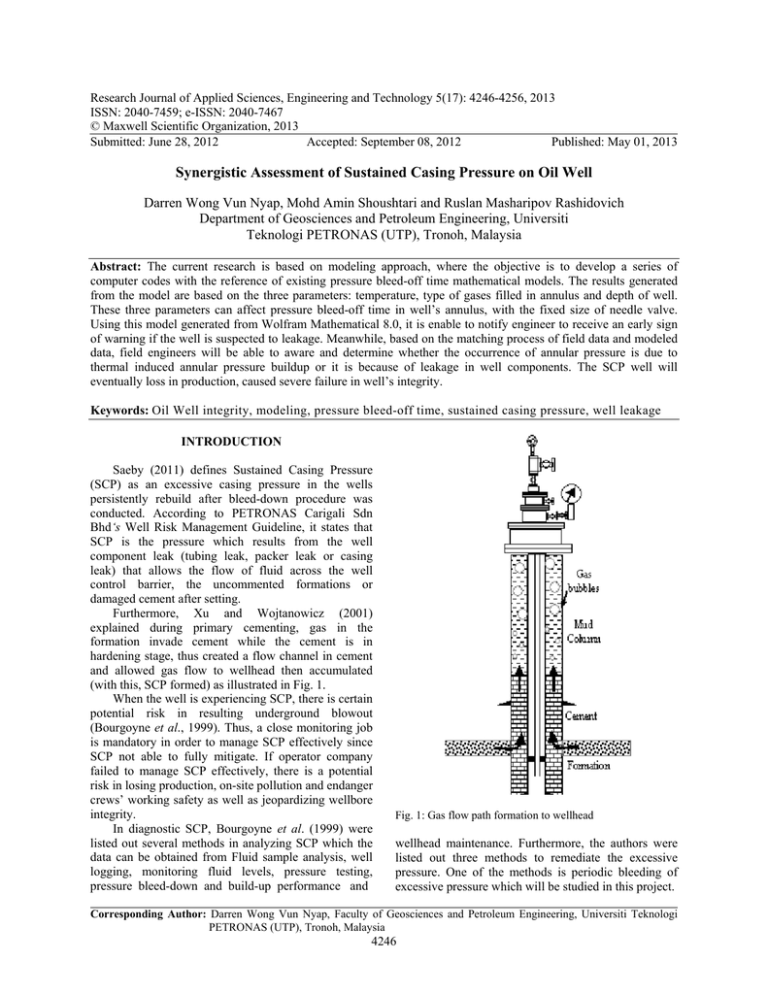
Research Journal of Applied Sciences, Engineering and Technology 5(17): 4246-4256, 2013 ISSN: 2040-7459; e-ISSN: 2040-7467 © Maxwell Scientific Organization, 2013 Submitted: June 28, 2012 Accepted: September 08, 2012 Published: May 01, 2013 Synergistic Assessment of Sustained Casing Pressure on Oil Well Darren Wong Vun Nyap, Mohd Amin Shoushtari and Ruslan Masharipov Rashidovich Department of Geosciences and Petroleum Engineering, Universiti Teknologi PETRONAS (UTP), Tronoh, Malaysia Abstract: The current research is based on modeling approach, where the objective is to develop a series of computer codes with the reference of existing pressure bleed-off time mathematical models. The results generated from the model are based on the three parameters: temperature, type of gases filled in annulus and depth of well. These three parameters can affect pressure bleed-off time in well’s annulus, with the fixed size of needle valve. Using this model generated from Wolfram Mathematical 8.0, it is enable to notify engineer to receive an early sign of warning if the well is suspected to leakage. Meanwhile, based on the matching process of field data and modeled data, field engineers will be able to aware and determine whether the occurrence of annular pressure is due to thermal induced annular pressure buildup or it is because of leakage in well components. The SCP well will eventually loss in production, caused severe failure in well’s integrity. Keywords: Oil Well integrity, modeling, pressure bleed-off time, sustained casing pressure, well leakage INTRODUCTION Saeby (2011) defines Sustained Casing Pressure (SCP) as an excessive casing pressure in the wells persistently rebuild after bleed-down procedure was conducted. According to PETRONAS Carigali Sdn Bhd‘s Well Risk Management Guideline, it states that SCP is the pressure which results from the well component leak (tubing leak, packer leak or casing leak) that allows the flow of fluid across the well control barrier, the uncommented formations or damaged cement after setting. Furthermore, Xu and Wojtanowicz (2001) explained during primary cementing, gas in the formation invade cement while the cement is in hardening stage, thus created a flow channel in cement and allowed gas flow to wellhead then accumulated (with this, SCP formed) as illustrated in Fig. 1. When the well is experiencing SCP, there is certain potential risk in resulting underground blowout (Bourgoyne et al., 1999). Thus, a close monitoring job is mandatory in order to manage SCP effectively since SCP not able to fully mitigate. If operator company failed to manage SCP effectively, there is a potential risk in losing production, on-site pollution and endanger crews’ working safety as well as jeopardizing wellbore integrity. In diagnostic SCP, Bourgoyne et al. (1999) were listed out several methods in analyzing SCP which the data can be obtained from Fluid sample analysis, well logging, monitoring fluid levels, pressure testing, pressure bleed-down and build-up performance and Fig. 1: Gas flow path formation to wellhead wellhead maintenance. Furthermore, the authors were listed out three methods to remediate the excessive pressure. One of the methods is periodic bleeding of excessive pressure which will be studied in this project. Corresponding Author: Darren Wong Vun Nyap, Faculty of Geosciences and Petroleum Engineering, Universiti Teknologi PETRONAS (UTP), Tronoh, Malaysia 4246 Res. J. Appl. Sci. Eng. Technol., 5(17): 4246-4256, 2013 Casing pressure (psi) 800 600 400 200 0 0 2 6 4 10 8 Time (sec) 12 14 16 Fig. 2: Instant bleed-down pressure pattern. Diagnostic testing of wells with sustained casing pressure-an analytical approach Casing pressure (psi) 1400 1200 1000 800 600 0 2 4 8 6 Time (sec) 10 12 14 Fig. 3: Prolonged bleed-down pressure pattern. Diagnostic testing of wells with sustained casing pressure-an analytical approach is reported one of the wells exhibiting a high casing pressure. Based on this observation, it is able to forecast that other wells in any part of the world might develop the same issue as developed in Gulf of Mexico; Periodic Bleed-off pressure is one of the methods to relief the SCP into minimum risk level. Riggs et al. (2001) stated that data obtained from periodic bleed-off pressure can contribute or provides utmost important information regarding the magnitude of leak in wellbore components and SCP problem. In addition, the data indicate that bleeding to zero pressure is not necessary a solution in mitigating SCP. Besides, Kinik and Wojtanowicz (2011) were claiming bleeding to zero pressure might causing hydrostatic pressure in the column decreased and thus induce influx of gas flowing into annulus column. Since periodic bleed-off pressure method was introduced, there is a need to develop computer codes from periodic bleed-off SCP method in order to make engineer’s life easier. After the computer codes were developed, the software application enables engineers to receive an early warning signal while monitoring ‘A’ annulus pressure. In addition, engineers will have an extra time to analyze SCP problem, modeling and become more effective in managing SCP before the problem become worst. The main objective of this study is to convert the existing mathematical model of periodic bleed-off SCP into a series of computer code and develop a SCP monitoring Workflow by using Wolfram Mathematical 8.0 software. LITERATURE REVIEW Causes of sustained casing pressure: The causes of SCP or referred as Sustainable Annulus Pressure (Attard, 1991) were casing leaks, insufficient isolation of cement and failure of completion string. In addition, Bourgoyne et al. (1999) were claiming that damage of primary cement after setting due to temperature cycles and casing contraction also were one of the causes to ̅ , exhibit SCP. Meanwhile, for Casing Leaks and √ ̅ ̅ ̅ ̅ ̅ ̅ completion string failure factor, Bourgoyne et al. (1999) were stated that leaks happened due to the poor thread connection, corrosion, thermal-stress cracking or After bleed down pressure process was done, Xu any mechanical failure of the inner string. However, the and Wojtanowicz (2003) were identified two patterns of cause due to insufficient isolation of cement is referring SCP testing pressure behavior namely pattern of instant to poor primary cementing job during completing the bleed-down and pattern of prolonged bleed down. casing into the well. It is because the invasion of gas Figure 2 shows the casing head pressure was release from formation into cement while the cement is in rapidly and the well liquid is also removed with the gas setting process. After cement was hardened, it will form in the same time. While Fig. 3 shows the prolonged a micro channels in the cement itself (Bourgoyne et al., process of pressure bleed down in order to minimize the 1999). removal of fluid in the casing annulus. If the cementing job was performed perfectly, yet it There is high number of wells in Gulf of Mexico still has a possibility to exhibit SCP in the future once area are developing potentially risk of SCP (Bourgoyne the well put on production phase. During the production et al., 1999). Apart from Gulf of Mexico, an oilfield phase, the changes in pressure and temperature are named Bakau Field in Malaysia, Sarawak Water Region causing expansion and contraction of the casing and the 4247 Following is the equation shows to determine the time taken to bleed the annulus to atmospheric pressure via bleed valve and assume this is gas well and annulus full of gas due to tubing leak: Res. J. Appl. Sci. Eng. Technol., 5(17): 4246-4256, 2013 cement sheath, thus resulting micro annulus in the cement. This finding was based on the experiment in examining the effect of increasing internal casing pressure who conducted by Jackson and Murphey (1993). Annular pressure: The effect of fluid temperature can lead to Annular Pressure Buildup (APB) in the well’s annulus. The high pressure reading at the surface might be due to APB which induced by thermal effect, once the pressure is bleed-off, ideally the pressure will not return unless there is a leak. Thus, Attard (1991) claiming that this could be temporary effect and did not present any hazardous situation to well integrity. In modelling Annular Pressure, Oudeman and Bacarreza (1995) were stated that, according to equation of state, the pressure at any point in the annulus is a function of mass of fluid m, volume Vann and temperature T: , , In addition, Oudeman and Bacarreza (1995) were obtained an expression to describe the changes of annular pressure as the following: Mass Influx or efflux from annulus volume Volume changes of annulus due to physical changes in annular volume Temperature Changes of the fluid Below is the expression in mathematical equation of Annular Pressure changes, Δp: ∆ , .∆ .∆ , , .∆ Below is the expression in mathematical equation of Annular Volume changes: ∆ , 2 ∙ , ∙ ∙∆ ∙∆ When the well is in shut in condition, following is the equation used to estimate the increase in the pressure on primary annulus: 1 ∆ ∆ 1 where, 1 Annuli pressure monitoring: It is important to monitor the annuli pressure in ensuring the well integrity; the following are the criteria in identifying the well which is potentially unsafe due to SCP as mentioned by Attard (1991): There is a direct pressure communication between annuli The inability to bleed down the annulus pressure to a designated minimum pressure There is a breakdown of casing shoe where the annulus pressure drops suddenly for no any valid reason Continuous of pressure build up where the pressure exceed the maximum pressure limit, even after bleed-off procedure was done In pressure monitoring process, a workflow model was developed by Attard (1991). Please refer to Appendix. Pressure bleed-down: It is essential to perform bleeddown pressure test in each well. According to Well Risk Management Guideline from PETRONAS Carigali Sdn Bhd, the guideline is mentioned the bleedoff test should be conducted for each of the well once, in every six months. From this statement, it clearly states that the company is highly emphasizing on well safety issue. In addition, Saadon et al. (2008) stated that bleed-downs activity is routinely completed in ensuring the well integrity of 781 offshore wells in Malaysia, based on this justification, Saadon et al. (2008) were developed pressure bleed down guideline for “A , B and C” annulus. From the bleed-off test, Riggs et al. (2001) explained the pressure bleed-down test is able to provide an important bleed down signature which can results the magnitude of leak. Furthermore, he is also claiming it is not recommended to bleed pressure to zero value because it might lead to casing collapse due to low hydrostatic pressure at inner casing string. Model in annular bleed-off time: Following is the description on model to estimate time taken to bleed a closed volume which containing gas as suggested by Riggs et al. (2001). There are 3 assumptions were made in the following equation which is: It is an ideal Gas Bleed-off annulus without influx The annulus filled with Gas (Air) instead of liquid Below is the equation of dimensionless time estimating for pressure bleed-down process based on the above 3 assumptions: 4248 Res. J. Appl. Sci. Eng. Technol., 5(17): 4246-4256, 2013 30 Percentage of leakage wells/% 25.5 25 23.2 20 17.9 15 12.9 9.22 9.21 10 11.1 6.86 5 4.11 1.69 Year 7 2 00 5 06 20 2 00 04 03 20 20 1 02 20 2 00 00 99 20 19 19 98 0 Q1 Fig. 4: Percentage of leaked wells versus year from 1998 to 2007. Assessment of well integrity on Norwegian continental shelf by SINTEF petroleum research ̅ ln 1 Following is the equation which shows the time taken to bleed the annulus to atmospheric pressure if the effect of leak influx is considered: ̅ √ ̅ ̅ ̅ ̅ ̅ ̅ , where β = ratio of the leak path area to nozzle area If β is assume to be zero: ln 1 organization solutions to reduce risk of uncontrolled release of formation fluids throughout the life cycle of a well. Basically it is all about the Safety which including personnel crew on board, well’s equipments located from subsurface until topside facility as well as the company’s business function. Nevertheless, the well integrity issue in this report will be focusing from subsurface until surface wellhead. Attard (1991) mentioned there are four potential hazards if annulus pressure is not able control with a proper procedure. Consequently, the high pressure below the wellhead could damage the wellhead itself and causing failure to contain all the fluids from subsurface. Secondly, pressure communication with formation can result in formation’s breakdown or fracturing. For instance, if the breakdown occurs in shallow formation, the fracture in the formation could transmit all the way to surface formation. It is indirectly providing an alternative channel to let the subsurface fluids escape to the atmosphere and provide an unnecessary contingency plan in order to isolate the problem. Thirdly, casing collapse could be happened if the pressures build up accumulate at ‘B’ or ‘C’ annulus where the pressure at ‘A’ annulus had been bleed off. Meanwhile, it may also damage the production tubing. The last but not least, there is a possibility lead to casing burst when hydrostatic pressure of completion fluid inside the annulus is extremely high. Hence, the effect of casing collapse and casing burst will potentially to let reservoir fluids escape from the wellbore; this incident can further exacerbate the well’s rehabilitation programmed such as Well Work over. If the integrity of well is jeopardized, it may lost its daily production and indirectly generate a negative impact to company’s business operation. Hence, Mineral Management Services (MMS) in U.S.A. was setting up the Self-departure regulation in observing SCP. Self-departure means the well will be freed from SCP observation and continue its own production. Following is the self-departure’s condition if SCP fulfill the below requirements: Well integrity issue: As the topic mentioned “Well Integrity”, what is so important of well integrity in oil and gas production? From the well integrity studies obtained from Randhol and Carlsen (2008) of SINTEF Petroleum Research, the integrity of wells at Norwegian SCP less than Minimum Internal Yield Pressure Continental Shelf is at risk due to several type leakages: (MIYP) leakage from tubing to ‘A’ Annulus, leakage at SCP will bleed down to zero psi within 24 hours Wellhead and leakage at down whole Safety Valve. In through ½ in. needle valve. addition, the number of leakage in wells also increasing by years as illustrated Fig. 4. However, Kinik and Wojtanowicz (2011) were If the leaks in wells are not taken seriously, stated that the pressure bleeding process may reduce eventually it will become a SCP in well and slowly fluid’s hydrostatic pressure; it may induce more gas deteriorating the integrity of wells as well as the safety influx flowing into annulus. Hence, pressure bleedof personnel crew. down to zero psi is not an ideal option to relieve The NORSOK-101 guideline defines well integrity is the application of technical, operational and pressure in well. 4249 Res. J. Appl. Sci. Eng. Technol., 5(17): 4246-4256, 2013 Fig. 5: Diagnosis of ‘A’ annulus. Best practices for prevention and management of sustained casing pressure. Stress Engineering Services Inc., Houston, USA Nowadays, it is the industry’s common practices in temporary remediation of SCP by implementing periodic bleed off and/or lubricating with high density completion fluid such as zinc bromide (Kinik and Wojtanowicz, 2011). With lubricate a high density completion fluid, it also increase the hydrostatic pressure which applied to casing shoe, high pressure at casing shoe resulting casing shoe breaching. Furthermore, D’Alesio et al. (2010) were developed an operational methodology to assess the well integrity through eliminating, at least reducing the risk in the presence of SCP in the well. First of foremost, the calculation needed to be calculated is Maximum Allowable Pressure (MAP) of each annular space in SCP well or it also can be referred as Maximum Allowable Wellhead Operating Pressure (MAWOP) according to API recommended practice 90. The MAWOP is measured relative to the ambient pressure at the wellhead for certain part of annulus. The implementation of diagnostics tests to detect the location and sizes of leakage on the critical well is crucially important. Once completed the diagnostic test, the team will starts to analyze the risk level to the well before they select the most appropriate remedial action to restore the integrity of well. Figure 5 shows a simple workflow diagram in diagnosis SCP in ‘an’ annulus who developed by Riggs et al. (2001). METHODOLOGY Research methodology: The sources of research are from books and technical papers. UTP IRC has become the main location to provide main source of research for books, while the ONE PETRO website under Society of Petroleum Engineers (SPE) is the main source of research for technical papers. The main objective of this research will be focusing on converting existing Mathematical model of pressure bleed-off time into computer code and perform sensitivity analysis by using software Wolfram Mathematica 8.0. Next objectives will be analyzing the detrimental effect of SCP on Well Integrity as well as developing a workflow in diagnostic SCP via software Wolfram Mathematica 8.0. Other than that, in order to have a better understanding of SCP on well integrity, such as the behavior of annular pressure in the function of changes in pressure, temperature, volume, basic understanding in casing design such as burst, collapse and formation breakdown will be studied as well so that the author will have a better idea on the effect of SCP which acting on Well integrity. After the computer code was developed, there is a need to validate the modeled data using hypothetical well parameters, with this it is able to evaluate the model developed from Wolfram Mathematica 8.0 is convincing and valid. Scope of research: The study is focusing on sustained casing pressure in ‘A’ Annulus which is the annulus between the production tubing and production casing instead of ‘B’ and ‘C’ Annulus which is the annulus between casings. Why focusing on ‘A’ annulus instead of ‘B’ and ‘C’ Annulus? According to Bourgoyne et al. (1999), they observed the trends of exhibiting SCP in production casing is 50% compare other type of casing such as intermediate casing (10%), surface casing (30%) and conductor casing (10%). Furthermore, Randhol and Carlsen (2008) from SINTEF Petroleum Research shows in Norwegian Continental Shelf, the percentage of leaking from production tubing to ‘A’ annulus is the second highest which is 30% compared to other type of leakage. Hence, the author realized that it is more important to focus at ‘A’ annulus as the frequency of leakage to occur is higher compare others leakage in ‘B’ and ‘C’ annulus. Basically, it is essential to know the behavior of annular pressure, interpretation of Bleed-down pattern and the effect of Sustained Casing Pressure (SCP) on well integrity. Figure 6 showing the location of ‘A’, ‘B’ and ‘C’ annulus in well. Parameters involved and formula: The following formula will be used in modeling the time during bleedoff pressure in annulus by Riggs et al. (2001): 4250 ln 1 Res. J. Appl. Sci. Eng. Technol., 5(17): 4246-4256, 2013 C annulus B annulus A annulus 18 5/8” casing shoe TOC 13 3/8 casing shoe TOC 9 5/8 casing shoe Fig. 6: Well schematic showing ‘A’,’ B’, ‘C’ annulus Table 1: Value of gas constant with various types of gases filled in annulus Type of gases Molecular weight Gas constant, ft lb/slug oR Carbon dioxide, CO2 44.01 1129.743 Oxygen, O2 32.00 1553.75 Air 28.97 1716.258 Nitrogen, N2 28.02 1774.45 Methane, CH4 16.04 3099.75 Helium, He 4.003 12420.68 Hydrogen, H2 2.016 24662.70 Please refer to Nomenclature section for the parameters involved in above equation. The parameters involved in above equation which are Va, R and T will be conducted a sensitivity analysis in order to observe the time required to bleed off with the changes of these parameters. Furthermore, according to API recommend practice 90 (2006), the parameter of a will be kept at constant value which is 0.5inc in this research study. In addition, the 0.5in needle valve is also typically used in the industry nowadays’ practice. According to Bellarby (2009), after the production stops, it is unavoidable that annulus pressure will drop below atmospheric pressure at surface. Furthermore, he also claiming that if the annulus was exposed or opened, or the valves are vacuum tight, air can enter the annulus and this can lead to corrosion problem in the future. Hence, the atmospheric pressure will be assumed more than 14.7 psi in the model. To observe the effect of gas constant in affecting time during bleed-off pressure test; several types of gases were selected. Table 1 is showing the molecular weight of gas with the respective of gas type filled in annulus. RESULTS AND DISCUSSION Analysis on well’s parameters: The effect of temperature: From Fig. 7, the estimated time in seconds to bleed-off the annular pressure is decreased when the average temperature of well is increased. At 660 oR, the time required to bleed-off is the highest compared to the other two temperature at 800oR and 1000 oR. This effect can be explained based on the physical understanding of gas law, as the average temperature in ‘A’ annulus higher, the energy of the fluid particles increase as well. As a result, the particles will travel with high speed of velocity in the confined space, the ‘an’ annulus. Therefore, when the needle valve at the surface is opened, the high energy of particles will flow and vent out from the valve with higher flow-rate. Given by: 4251 Res. J. Appl. Sci. Eng. Technol., 5(17): 4246-4256, 2013 where, P is the pressure of fluid particles, A is cross section area, a is acceleration, v is velocity of particles and t is time. By substituting equation (A2) into equation (A1): T = 660 oR T = 800 oR Bleed off time.sec 12000 T = 1000 o R 10000 8000 6000 500 1000 1500 2000 Pressure (psi) Fig. 7: Time bleed-off pressure temperature at 3000psi model 2500 3000 for varying Bleed off time (sec) 2000 CO 2 O2 1500 N2 Air CH 4 1000 He H2 500 500 0 1000 1500 2000 Pressure (psi) 2500 3000 Fig. 8: Time bleed-off pressure model for different types of gases at 3000psi Bleed off time (sec) 2000 L = 10000 ft 1500 L = 7000 ft 1000 L = 3000 ft 500 500 1000 1500 2000 Pressure (psi) 2500 3000 Fig. 9: Time bleed-off pressure model for different height of gas column at 3000psi (A1) where, and thus, (A2) (A3) From the equation (A3), it is clear that when the relationship of temperature and time is inversely proportional, when the temperature increasing, the time required to bleed off is decreasing with the increasing of speed travel of particles via needle valve. The effect of gas type filled in annulus: Different types of gas may result into different time estimated to bleed-off pressure at ‘an’ annulus. As Fig. 8 shows, annulus filled with Carbon Dioxide (CO2) gas required longest time to bleed-off the pressure, whereas the shortest time required bleed-off is Hydrogen (H2) gas. In addition, the results also showing that increasing in molecular weight of gas would increase the time bleedoff and vice versa. Furthermore, there is very close result of pressure bleed-off time between the Air and Nitrogen gas (N2). This is due to the Air contained about 78.1% of Nitrogen gas and both gases have also the same number of molecular weight. Hence, the pressures bleed-off time almost similar for Air and N2 gas. According to Bellarby (2009), gas is a good insulator due to low conductivity and limit-free convection compare to liquid. Nowadays, Nitrogen gas is commonly used as packer fluids to fill in the annulus of some wells. This is due to Nitrogen has a very stable triple-bonded molecular structure. Oxygen gas (O2) is not recommended to use as packer fluids based on the best level of author’s knowledge, as O2 gas is one of the essential elements for ignition. Meanwhile, the well is producing hydrocarbon and the hydrocarbon is the main sources to fire in order to continue burning, also add with the third element, Heat. Hence, Fire will be occurred. From the discussion above, this will definitely jeopardize the well’s integrity and meanwhile, the utmost important concern is the safety of the crew on board. Furthermore, according to Riggs et al. (2001), they were claimed that O2 gas is commonly known as corrosion agent, this type of gas may result in high corrosion rates in steels material such as casing or tubing. Therefore, it is not recommended to inject O2 gas into well’s annulus based on the justification as discussed above. The effect of Height of annulus column: The depth of well is also one of the factors in alternating the estimated time for pressure bleed-off. As shown in Fig. 9, with the radius of annulus is fixed through a 4252 Res. J. Appl. Sci. Eng. Technol., 5(17): 4246-4256, 2013 Fig. 10: 3D view of pressure Vs bleed-off time Vs temperature fixed tubing size and casing size in this model of study; the deeper well is required longer time to bleed-off compare to shallower well. For instance, Fig. 9 shows the bleed off time at 10,000 feet of Well is the highest compare to the other depth of Well which located at 7000ft and 3000ft. From the observation, this is due to the volume of gas column increase with length, the deeper the well, the capacity to cater a huge quantity of gas is higher and vice versa. Thus, it is request a longer time to bleed-off. The following 3D plot, Fig. 10 is generated to improve the visualization and better understanding the relationship among bleed-off time, pressure in annulus and well’s temperature. The Fig. 10 can be rotated 360degree in Wolfram Mathematical 8.0. From the 3D view above, the relationship between bleed-off time and temperature of well can be described effectively. As the Temperature, or increase, the required time to bleed-off is decreasing. On the other side, it shows the bleed-off curve according to initial pressure in the well. Workflow diagram on diagnostic SCP in wells: Via using Wolfram Mathematica 8.0, the workflow diagram on diagnostic SCP was developed in order to get our users to have a better visualization on the estimated time pressure bleed-off while diagnosing the SCP in wells. Please refer Appendix of the Workflow diagram. Note: The mathematical model of time estimated for pressure bleed down is assumed the well is free from any leakage. With this assumption made, following are the procedure in diagnostic SCP. Once the engineer obtained the annular pressure report from site personnel, the data from the report need to be compared with the modeling data after the model is generated with provided well parameters. Then, he/she need to start matching process from the both set of data. If both data is matched, it means the well only exhibits thermal induced APB (Annular Pressure Buildup). Hence, it just needs to bleed off the pressure in ‘A’ annulus in order to relief the pressure. After that, continue back to daily monitor annular pressure. On the other side, if both set data is not matching, it means the well is suspect leaking, thus engineer should contact back to site personnel and request them to observe whether there is any hydrocarbon in the bleed fluids or not. If there is no any hydrocarbon fluid observed in bleed fluid, engineer should inform them to continue monitor the annular pressure. If the annular pressure is manageable, then continue back to daily monitoring process. Otherwise, immediately stop the production and report to reservoir management team. However, if there is any hydrocarbon fluid observed in bleed fluid during the observation, immediately contact reservoir management team at KLCC for any necessary remedial action. Case Study: Occurrence of high casing annulus pressure issue in Baram delta, Sarawak Malaysia: The author had done a research on the trend of high casing head pressure issue happening in Baram Delta, Sarawak, Malaysia. Figure 11 shows the number of wells exhibiting high casing head pressure. From the 4253 Res. J. Appl. Sci. Eng. Technol., 5(17): 4246-4256, 2013 CHP >500psi CHP >1000psi Number of Wells 45 40 35 30 25 20 15 10 5 0 July Aug Sept Oct Months of 2010 Fig. 11: High casing head pressure in Baram Delta, Sarawak, Malaysia observation by months in the year of 2010, the number of wells which are more than 1000psi is increasing steadily from 3 wells to 9 wells within 4 months. Moreover, every month there are at least more than 20 wells which are exhibiting more than 500psi. In September 2010, there are 41 wells exhibits more than 500psi of casing head pressure. It can be interpreted there is an increasing trend of casing head pressure in the future time and it is same goes to wells which more than 1000psi. Since some of the wells in Baram Delta are one of the longest history in producing oil and gas, it may indicates probably there will be certain number wells is aging well and this also increase the possibility of leakage in well components. Hence, from the trend there will be more number of wells will exhibit high casing head pressure in the future period and this phenomena perhaps will apply into another region in Malaysia such as Sabah oilfield and oilfield at East peninsular of Malaysia. The following 3D plot, Fig. 10 is generated to improve the visualization and better understanding the relationship among bleed-off time, pressure in annulus and well’s temperature. The Fig. 10 can be rotated 360degree in Wolfram Mathematical 8.0. From the 3D view above, the relationship between bleed-off time and temperature of well can be described effectively. As the Temperature, or increase, the required time to bleed-off is decreasing. On the other side, it shows the bleed-off curve according to initial pressure in the well. Note: The mathematical model of time estimated for pressure bleed down is assumed the well is free from any leakage. With this assumption made, following are the procedure in diagnostic SCP. Once the engineer obtained the annular pressure report from site personnel, the data from the report need to be compared with the modeling data after the model is generated with provided well parameters. Then, he/she need to start matching process from the both set of data. If both data is matched, it means the well only exhibits thermal induced APB (Annular Pressure Buildup). Hence, it just needs to bleed off the pressure in ‘A’ annulus in order to relief the pressure. After that, continue back to daily monitor annular pressure. On the other side, if both set data is not matching, it means the well is suspect leaking, thus engineer should contact back to site personnel and request them to observe whether there is any hydrocarbon in the bleed fluids or not. If there is no any hydrocarbon fluid observed in bleed fluid, engineer should inform them to continue monitor the annular pressure. If the annular pressure is manageable, then continue back to daily monitoring process. Otherwise, immediately stop the production and report to reservoir management team. However, if there is any hydrocarbon fluid observed in bleed fluid during the observation, immediately contact reservoir management team at KLCC for any necessary remedial action. Case Study: Occurrence of high casing annulus pressure issue in Baram delta, Sarawak Malaysia: The author had done a research on the trend of high casing head pressure issue happening in Baram Delta, Sarawak, Malaysia. Figure 11 shows the number of wells exhibiting high casing head pressure. From the observation by months in the year of 2010, the number of wells which are more than 1000psi is increasing steadily from 3 wells to 9 wells within 4 months. Moreover, every month there are at least more than 20 wells which are exhibiting more than 500psi. In September 2010, there are 41 wells exhibits more than 500psi of casing head pressure. It can be interpreted there is an increasing trend of casing head pressure in the future time and it is same goes to wells which more than 1000psi. Since some of the wells in Baram Delta are one of the longest history in producing oil and gas, it may indicates probably Workflow diagram on diagnostic SCP in wells: Via there will be certain number wells is aging well and this using Wolfram Mathematica 8.0, the workflow diagram also increase the possibility of leakage in well on diagnostic SCP was developed in order to get our components. Hence, from the trend there will be more users to have a better visualization on the estimated number of wells will exhibit high casing head pressure time pressure bleed-off while diagnosing the SCP in in the future period and this phenomena perhaps will wells. Please refer Appendix of the Workflow diagram. 4254 Res. J. Appl. Sci. Eng. Technol., 5(17): 4246-4256, 2013 apply into another region in Malaysia such as Sabah oilfield and oilfield at East peninsular of Malaysia. CONCLUSION The idea of proposing this project is due to the operation engineer in oil and Gas Company rarely performs and emphasis on this bleed off practice. Hence, the author believes that this is important to practice in contributing higher safety factor in wellbore and crew on board, so this practice should be practiced for the benefit of the company and its people. The findings shows that it is important to monitor annulus pressure in order to further ensure well safety. The bleed-off test is performed to ensure well safety. The mathematical model for time estimated to bleed down pressure is assumed that the well is free from any leakage. Based on the bleed off curve, it is useful for well integrity engineer to identify whether the pressure is caused by thermal Annular Pressure Buildup (APB) or the leaking in well’s components. With this, the company able to save the pre- diagnostic cost until the well is needed for further confirmation. If the data matched the bleed-off curve, then it can be assumed as a thermal APB. Otherwise, this it can be assumed there is a sign of leakage in any well components. Furthermore, this method can be very useful for unmanned offshore platform, where the engineers can directly perform bleed-off pressure using automatic remote system and they can perform real time pressure monitoring in the office without any site visit. Besides that, this research study has given a holistic idea on SCP’s physical phenomena and its detrimental effect on Well Integrity. RECOMMENDATIONS There are still further works that need to be done for this project. Following are the recommendation for any future references: It is suggested the word of Sustained Casing Pressure (SCP) can be replaced into Excessive Annular Pressure since the project is all about the pressure changes in annulus. Appendix: 4255 Res. J. Appl. Sci. Eng. Technol., 5(17): 4246-4256, 2013 It is recommended to obtain field data in order to make sure the simulated data are more convincing and reliable. Thus, it is suggested to organize a trip to visit an oil and gas operating company in order to extract any relevant data set. It is recommended to develop a pressure build up pattern in order to further improve the diagnostic process. NOMENCLATURE An Bann β = = = Do Di Et Lann ̅ = = = = = = Patm Pi Pf pann R rt rc t T Va = = = = = = = = = = Nozzle Area Fluid bulk Modulus in Annulus Ratio of flow area of the leak to flow area of nozzle Outer diameter Inner diameter Modulus of elasticity of tubing Uncemented length of annulus Ratio of tubing pressure to atmospheric pressure Ratio of Annular Pressure to atmospheric pressure Atmospheric pressure Initial Pressure Final Pressure Annulus Pressure Gas constant Outer radius Inner radius of casing Time Average Temperature of the gas Volume of the gas in annulus REFERENCES Attard, M., 1991. The Occurence of Annulus Pressure in the North West Hutton Field: Problems and Solutions. Proceeding Of SPE 23136, Offshore Europe Conference. Aberdeen, U.K. Bellarby, J., 2009. Well Completion Design. Development of Petroluem Science, Elsevier B.V., Oxford, U.K. Bourgoyne, A.T., S.L. Scott and J.B. Regg, 1999. Sustained casing pressure in offshore producing wells. Proceeding of (OTC 11029), Offshore Technology Conference. Houston, Texas. D’Alesio, P., R. Poloni, P. Valente and P.A. Magarini, 2010. Well integrity assessment and assurance: The operational approach for three Co2 storage fields in Italy. Proceeding of SPE 133056, SPE Annual Technical Conference and Exhibition. Florence, Italy. Jackson, P.B. and C.E. Murphey, 1993. Effect of casing pressure on gas flow through a sheath of set cement. Proceeding of SPE/IADC Drilling Conference, Amsterdam. Kinik, K. and A.K. Wojtanowicz, 2011. Identifying environmental risk of sustained casing pressure. Proceeding of SPE 143713, SPE Americas E&P Health, Safety and Environment Conference. Houston, Texas. Oudeman, P. and L.J. Bacarreza, 1995. Field trial results of annular pressure behavior in a highpressure/ high-temperature well. Proceeding of Offshore Europe Conference. Aberdeen, U.K. Randhol, P. and I.M. Carlsen, 2008. Assessment of sustained well integrity on the norwegian continental shelf. Porceeding of 4th Meeting of the IEA-GHG Wellbore Integrity Network. 18-19 March, Paris, France. Riggs, K.R., U.B. Sathuvalli, P.V. Suryanarayana, W.T. Asbill, R.A. Sukup and B.D. Scott, 2001. Best Practices for Prevention and Management of Sustained Casing Pressure. Stress Engineering Services Inc., Houston, USA. Saadon, K., T. Lane and M.D. Murrey, 2008. Optimizing well integrity surveillance and maintenance. Proceeding of IPTC 12624, International Petroleum Technology Conference. Kuala Lumpur, Malaysia. Saeby, J., 2011. Sustained Casing Pressure Guideline. WI Workshop Presentation, Norske Shell, Jan Sæby. Xu, R. and A.K. Wojtanowicz, 2001. Diagnosis of sustained casing pressure from bleed-off/buildup testing patterns. Proceeding of SPE 67194, SPE Production and Operations Symposium. Oklahoma, USA. Xu, R. and A.K. Wojtanowicz, 2003. Diagnostic testing of wells with sustained casing pressure-an analytical approach. Proceeding of Canadian International Petroleum Conference, Canada. 4256
